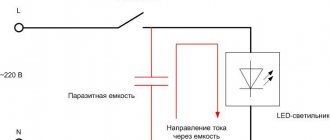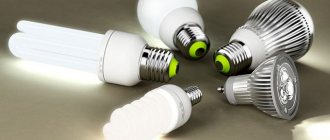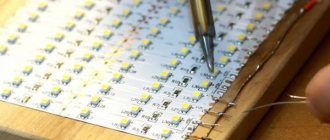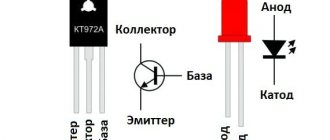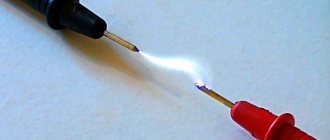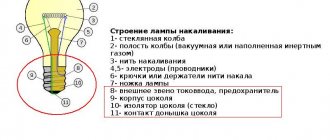LED lamp glows when switch is off
If you are faced with the problem that the LED lamp is on when the switch is off, do not be surprised.
This indicates that current is flowing through the LEDs. The brightness of the glow depends only on its strength. On the one hand, this phenomenon has a positive side, if the lighting is in the toilet or corridor it can be used as night lighting. What if it’s in the bedroom? It is possible that the light does not smolder, but flashes periodically.
There may be several reasons for this phenomenon:
Low quality LEDs
Contrary to popular belief, the quality of the light-emitting elements is unlikely to be the sole reason why an LED lamp glows on its own after being turned off. Theoretically, cheap LEDs of unknown origin may have low substrate insulation resistance, but this will more likely lead to leakage of current, initiating the glow. Such a defect should be revealed the first time the lamp is turned on during inspection during purchase, and any consumer will refrain from purchasing a lamp with reduced brightness or no glow.
Related video: The lamp shines but not brightly
Illuminated switch
The most common reason for a lamp to glow after being turned off is backlit switches.
Inside such a switch there is an LED with a current-limiting resistor. The LED lamp glows dimly when the light is turned off, because even when the main contact is turned off, voltage continues to flow through them.
Why does an LED lamp burn at full heat and not at full power ? Thanks to the limiting resistor, the current flowing through the electrical circuit is extremely insignificant and insufficient to light an incandescent electric lamp or ignite fluorescent lamps.
The power consumption of LEDs is tens of times lower than the same parameters of an ordinary incandescent lamp. But even a small current flowing through the backlight diode is sufficient for the LEDs in the lamp to glow weakly.
There can be two lighting options. Either the LED lamp lights up continuously after turning off, which means that sufficient current flows through the LED backlight of the switch, or the light flashes periodically. This usually happens if the current flowing through the circuit is too small to cause a constant glow, but it recharges the smoothing capacitor in the power supply circuit.
When sufficient voltage gradually accumulates on the capacitor, the stabilizer chip is triggered and the lamp flashes for a moment. Such blinking must be definitely combated, no matter where the lamp is located.
In this operating mode, the lifespan of the power board components will be significantly reduced, since even the microcircuit does not have an infinite number of operation cycles.
There are several ways to eliminate the situation when the LED light is on when the switch is off.
The simplest is to remove it from the backlight switch. To do this, we disassemble the housing and unscrew or bite off with wire cutters the wire going to the resistor and LED. You can replace the switch with another one, but without such a useful function.
Another option would be to solder a shunt resistor in parallel with the lamp. According to the parameters, it should be designed for 2-4 W and have a resistance of no more than 50 kOhm. Then the current will flow through it, and not through the power driver of the lamp itself.
You can purchase such a resistor at any radio store. Installing the resistor is not difficult. It is enough to remove the lampshade and fix the resistance legs in the terminal block for connecting the network wires.
If you are not particularly friendly with electricians and are afraid to “interfere” with the wiring yourself, another way to “fight” backlit switches can be to install a regular incandescent lamp in the chandelier. When turned off, its spiral will act as a shunt resistor. But this method is only possible if the chandelier has several sockets.
Switch light problem
The most common question is “Why do LED bulbs continue to light when the switch is off?” people are using illuminated switches indoors. A miniature neon light bulb (sometimes an LED) located inside the housing does not affect the operation of the lamp when the light source is an incandescent or halogen lamp. If you screw an LED light bulb into a lamp, it will often continue to burn dimly even after the voltage is removed.
Why this happens becomes clear if you carefully look at the diagrams for turning on a light bulb through an illuminated switch, given below. From the diagrams it follows that at load L1 after turning off the lighting there is still a small potential that penetrates through the neon light bulb circuit (Fig.
Designations on the diagrams:
- HL1 – LED or neon backlight;
- D1 – diode limiting reverse voltage;
- L1 – LED main lighting lamp;
- S1 – illuminated switch.
There are three ways to fix this problem:
- Replace the existing switch with a regular one or remove the backlight from it yourself.
- Install a resistor (Fig. 3) or capacitor (Fig. 4) in parallel with the load. The radio element can be placed in the distribution box, in the lamp socket itself, or on the back of the switch if both the phase and neutral wires pass through it. In the first case, you will need a resistor R2 with a nominal value of 50 kOhm and a power of 2 W or a power of 0.5–1 W, but with a resistance of 1 MOhm. The compactness and low cost of the resistor, in this case, is an undeniable plus. But there is also a negative point - active power consumption and slight heating. The second option with capacitor C1 is free of the negative moments of the resistor and is able to compensate for network interference from other electrical appliances in the room. Installation requires a non-polar capacitive element. It is recommended to use a capacitor with a capacity of 0.1 to 1 µF, capable of withstanding a voltage of 630 volts.
- Removing the barely noticeable glow of several LED lamps is not difficult if they are powered from one switch. To do this, one of the LED lamps must be replaced with a low-power incandescent lamp. The tungsten filament will act as a shunt resistor, allowing harmful current from the backlight to pass through it. As a result, none of the lamps connected in parallel will light when the switch is off, since there is not enough current to ignite the filament.
Why this happens becomes clear if you carefully look at the diagrams for turning on a light bulb through an illuminated switch, given below.
The lamp may not turn off completely for months. At this time, the crystal ages, its brightness decreases, and its resource is exhausted. Having figured out why the LED bulbs light up dimly after turning off the lights, you can try to fix the problem yourself. This will require basic knowledge of electrical engineering and the ability to use tools. If you lack the skills, it is better to call an electrician.
If the lamp cannot be turned off completely due to the LED light switch, the first tip is to replace the device. A model without additional functions will not cause a glow. The device with the LED element is installed in another place where it will not create difficulties. Another way out is to remove the backlight. The switch body is unscrewed, the wire to the chip is cut with a tool. Before starting electrical installation work, turn off the power supply to the panel.
If an LED is needed, look for a design solution.
- Replace one of the LED fixtures in the lamp with an incandescent lamp. She will take away the free current. This method is only suitable for devices with several horns. The disadvantage of this method is that the energy-saving effect of lighting is reduced.
- A more labor-intensive option is to install a resistor in parallel with the lamp in the circuit. Its resistance should be up to 50 kOhm. The current will go to the resistor, the capacitor will remain without charge. The radio component is purchased at a specialized store. When installing the legs, the parts are fixed to a terminal with wires.
The problem with the wiring is solved by replacing the section with poor insulation. To find the damaged area, you will need a special device - a multimeter. When cables are installed openly, it is not difficult to find damaged insulation. Hidden placement of wires will require dismantling the decorative coating or plaster. Depending on the state of communications, a separate section or the entire wire is replaced. After installation, the grooves are sealed with gypsum mortar.
Why LED lamps may glow dimly after being turned off
The basis of this unpleasant situation is the ability of LEDs to glow even at low current (albeit not at full intensity). But the reasons for the occurrence of this current when the switch is open can be different.
Switch with LED indicator
Switches with LED (or halogen) backlighting are popular in everyday life. When used in conjunction with incandescent lamps, such switching elements do not create problems. The small current required to light the backlight is limited by a resistor, and is clearly not enough to light a traditional lamp. LED lamps are another matter. A small current can charge the input capacitor of the electronic driver. By accumulating charge and periodically discharging through the circuit, the capacitor can cause LED flashes. If the lamp uses a circuit with a ballast resistor, the current may be enough to dim the LED.
Electrical wiring fault
The glow when the switch is open can be caused by leakage currents in the network. As insulation ages, leaks can appear anywhere and cause voltage to appear in unexpected places. In this case, small currents arise, but they can cause a weak glow of LED illuminators.
Influence of capacitive couplings
In some cases, leakage occurs through capacitive coupling. One plate of the capacitor is formed by a phase or neutral wire. The other is a wire laid nearby, a grounded metal element (reinforcement), a damp wall or ceiling, etc. It is difficult to detect this problem using a megger - it works with a constant voltage.
Capacitive coupling between the phase and neutral wires can create a problem if there is little voltage present on the neutral wire. This is a common phenomenon and is caused by the asymmetry of the loads along the phase wires. Then, when the phase wire is broken by the switch, a small current will arise through the capacitance between the wiring of one lamp, which will be sufficient to ignite the LED.
There may also be a interference problem. If another conductor loaded with a powerful load is laid parallel to the phase or neutral wire not far and over a long distance, then the current flowing through it creates a noticeable electromagnetic field. It can induce sufficient current in nearby lines.
Poor quality LED light bulb
If inexpensive light bulbs from unknown manufacturers from Southeast Asia are used for lighting, then poor workmanship can also be the cause of unauthorized lighting:
It is impossible to predict the manufacturer's imagination in this direction. With a single purchase, such a device is easy to identify during the initial inspection. If a defect is discovered, you can refuse to purchase. But this problem can be missed when purchasing a large batch of lamps (for example, for an organization) - it is impossible to check all the devices. And the defect may not manifest itself immediately.
Incorrect connection of the LED lamp
The switching circuit of the lamp may be assembled incorrectly - when turned off, it is not the phase conductor that opens, but the neutral conductor. If there is a small leak or if there is capacitive coupling in the circuit, conditions will be created for current to flow through the light-emitting elements. This situation is also dangerous because even with the switch open, the luminaire elements will be under mains voltage. This creates a real risk of electric shock when repairing or servicing the lighting system.
How to fix the problem
The method for troubleshooting depends on its origin. In order of the reasons listed in the first part of the review:
It is even better, instead of a resistor, to connect a capacitor with a capacity of no more than 0.01 μF and a voltage of at least 400 V. If the lamps form a parallel group, one additional element is sufficient for all lamps. You can connect it directly to the socket - it’s more convenient. You can also replace one LED lamp from the group with an incandescent light bulb.
It should be understood that often the capacitive coupling problem cannot be solved even by replacing the wiring. The improved insulation of the new wire will only increase the capacitance of the parasitic capacitor. Therefore, you will have to radically change the topology of the wires. This is expensive in terms of finances, labor and time. It may be cheaper to abandon LED lighting in favor of incandescent light bulbs until the next major renovation of the room.
The problem of the glow of LED lamps is not unsolvable. The question is correct diagnosis - here an error can lead to unjustified financial and time losses.
Why is the LED lamp blinking?
Why the microwave works but does not heat - all the reasons
What to do if your phone stops charging from the charger - the main reasons
Why does the plug, RCD or automatic circuit breaker knock out when turning on or during operation of the washing machine?
Why do you need a dimmer, what is it, dimmer connection diagram and how it works
What is a halogen lamp, where is it used, how to choose a halogen lamp for your home
Source
Why does an LED lamp continue to burn dimly when the lights are off?
There are several reasons why an LED lamp continues to burn dimly even after being turned off, and there are several suggestions for eliminating them.
LEDs may burn dimly due to the poor condition of the wiring and its poor-quality insulation, incorrect connection of the lamps and their poor quality.
Poor quality insulation
If the wiring is old and the insulation is of poor quality, the LED lamp may burn dimly even when the light is turned off.
Poor-quality insulation allows current to pass, which is enough to make the LEDs glow weakly.
Illuminated switches
If your home has backlit switches, then when purchasing LED bulbs and strips you should pay attention to the instructions for their use. The packaging may indicate that this type of light bulb is not recommended for use with switches that have a backlight.
LEDs have a filter capacitor designed to smooth out the voltage. This device accumulates voltage inside itself, which “turns on” the LED light bulb.
When the light is on, all input voltage goes to the lamp. When the lights are turned off, the electrical circuit is open, but a small amount of current continues to flow to power the LED or neon light bulb in the backlight. The current, even such a small power, is enough to start the diodes, which begin to blink or glow dimly.
Low quality light bulb
Inexpensive LED light bulbs often do not work properly, flickering and dimming when turned off.
In the case of LED strips, they will continue to burn dimly after being turned off if an insufficient power supply was installed.
Low-quality LEDs may use chips and boards made of cheap materials, which cause errors in their operation, including burning at full intensity, glowing after switching off, etc.
Electrical wiring problems
Electrical wiring must be replaced every 10-15 years. Naturally, over such a period of time it wears out and problems arise in the operation of the light bulbs. The fact that apartments use an increasing amount of electronics also plays a role, and the wiring cannot withstand such a load. The result is a small amount of current leakage, enough to keep the LED bulb dimly lit when the lights are off.
Incorrect operation of LEDs can also occur if the internal wiring is incorrectly connected, that is, the phase goes directly to the light bulb, and a switch was installed on the neutral wire. In this case, the LED is constantly energized, despite the fact that the electrical circuit is open.
Reasons why the LED is half lit
The reason why the LED is half lit is located inside the lamp. Poor-quality driver parts (electronic board inside the device) can distort the supply signal, reduce its power or fail to maintain voltage stabilization, which leads to failure of semiconductors.
Another reason why an LED lighting lamp with an E27 socket may glow as if at half the strength may be a wiring fault. The reduced intensity of the lamp glow is possible due to the fact that oxidation of the connections in the wiring boxes of the electrical power circuit has occurred. To eliminate it, just check the tightness of the twists or the degree of clamping of the terminals. If this problem is not corrected for a long time, the semiconductor lamp may fail, since the increased contact resistance between the conductors can cause significant fluctuations in current and voltage, which negatively affects the performance of the device.
Features of the power supply circuit
There are two schemes for connecting LED lamps:
In the second case, it is necessary to use a resistor that limits the current. You can find out the required power when purchasing it in a store.
The resistor has the ability to accumulate thermal energy, which is enough to dimly glow when the LED lamps are turned off.
If we are talking about T8 LED lamps (in the form of a tube), then connecting them to additional devices is not required - everything you need is in the lamp itself.
This is interesting! There are LED lights designed specifically to accommodate LED bulbs that will not dim when turned off.
If you want to replace an incandescent light bulb in a lamp with an LED one, then the voltage on its packaging should indicate 220 V. Next, we select according to the type of base (for example, E14 or E27 are the most common). In order not to make a mistake with the size of the base, you can take an old light bulb to the store.
What to do and how to fix the problem
You can eliminate the causes of dim LED lighting yourself or, in some cases, by contacting an electrician.
The problem of poor wiring insulation can be solved by replacing it or re-insulating the damaged area. The location of poor-quality insulation is determined by special devices (homemade or purchased) in this way: within a minute, the maximum voltage is applied to the network and, with the help of special equipment, the location of the current leak is found. If you have no knowledge of electrical engineering, then it is better to trust a specialist.
Many manufacturers have begun to write on the packaging of LED lamps that their use is not recommended if there is a backlit switch. If there were no instructions on the packaging, you screwed the LED light bulb into the lamp, and it continues to glow faintly when turned off, you should try the following:
LED lamps can burn when the switch is off due to the specificity of their design. Thus, the LED driver includes a capacitor capable of storing electricity. This design feature of LED light bulbs does not allow them to go out immediately after turning off, and they continue to glow faintly.
It is not recommended to purchase products from unknown manufacturers. They will not work correctly and will not last long and will burn after being turned off. In addition, a defective product can cause harm to the eyes due to flickering, white color temperature (instead of the declared warm light), etc.
If the electrical wiring is old, it must be replaced. In this situation, the best solution is to entrust the work to an electrician.
If the zero and phase are connected incorrectly, you need to reconnect: the phase to the switch, and the neutral wire to the light bulb.
The problem can be eliminated by purchasing a resistor made of special materials that prevent the accumulation of thermal energy.
Design feature of the LED lamp
The second most common reason why an LED lamp lights up dimly when the switch is off is hidden in its driver. And this is not surprising, because every manufacturer of LED products uses dozens of types of driver circuits, constantly changing and improving them. But often such changes are made with one goal - to reduce the cost of the finished product. But as a result, due to the use of low-quality components and errors made when assembling the driver, the LEDs remain lit even when the lights are turned off. Such a malfunction does not reduce the service life of the LED lamp, but it cannot be eliminated.
Tips for choosing LED lamps
Organizing lighting with LED lamps is economically beneficial, but requires a certain approach to their selection.
The first thing to remember is that LED lamps cannot be cheap. Their design is very complex and requires certain production costs.
The second point is the instructions included with the light bulb. Study it carefully. Points that you should pay attention to in order to choose a high-quality light bulb that does not blink when turned off:
Attention! Some types of lamps have the ability to glow after being turned off. You will find information about this in the instructions for it.
More than half of the reasons for LEDs dimming when turned off is a backlit switch or poor quality of the light bulb.
To prevent combustion when switched off, when purchasing, you need to carefully read the instructions and choose a light bulb that suits the specific case.
Sometimes it is impossible to completely eliminate the weak burning of LED lamps when they are turned off. Their design is complex, and even trusted manufacturers can have similar problems (although less often than manufacturers of low-quality light bulbs).
Source
Why do LED lamps glow when the switch is off?
Replaced the light bulbs in the chandelier with LED ones. But one of the bulbs lights up even when the switch is off. Replacing the bulbs with different ones did not help. What to do?
Today, LED lamps are one of the most popular light sources, as they are economical, last a long time and are fireproof. Why does the problem arise when the LED lamp glows when the switch is off? We will deal with this issue in this article, and also consider methods for eliminating the glow.
Such lamps operate at constant voltage and have a rectifier inside. LEDs produce light by applying an alternating voltage. Before understanding the reasons why an LED lamp burns after turning off the power, you need to consider the principle of its operation and the features of the lamp.
Why does an LED lamp burn at full intensity - features of the design and operation of the lamp
The design of an LED lamp consists of a base, driver, radiator, bulb and board with LEDs.
The light source is powered through an alternating electric current network, the voltage of which is reduced by the driver. The radiator is responsible for removing heat from the LED elements - they heat up when the lamp is on. If an LED lamp is used instead of a traditional incandescent or halogen lamp, it is necessary to select the power and brightness corresponding to the previous light sources and lamp. These features of the operation of LED lamps make it possible to understand why the LED lamp burns at full intensity. It is worth noting that a frequent search on the Internet that includes the word “in full swing” is incorrect. The correct word to use is “full heat”.
Features of LED lamp
The design of this type of lamp is more complex than its analogue with an incandescent filament. The principle of operation is based on the recombination of electrons and holes with transfer to another energy level, resulting in a glow that is a consequence of the release of photons.
These processes are facilitated by the use of certain LED semiconductor materials.
To understand why LED lamps light up when the lights are off, you need to look into its structure. The stores offer illuminators of different sizes and shapes. The internal structure is also different.
Probably everyone has noticed large differences in the price category of this product, from 100 rubles to a thousand. It is the features of the device that determine such a wide range.
To ensure acceptable lamp operating conditions, a current-limiting element is used. In simpler circuits, a resistor is used for this purpose.
Higher quality light sources operate on a different principle: the circuit is based on a diode bridge, which rectifies the mains voltage and supplies it to LEDs connected in series.
One of the main differences between modern lighting and conventional incandescent lighting is a constant supply of current; such circuits are called rectified.
The capacitor, which converts and stores energy, is located on the driver. Then the current is supplied through the circuit to the board, from it to the chips and diodes. A high quality LED lamp has a slightly different operating principle.
The basis is a diode bridge; it supplies energy to the LEDs in a series connection. Such sources will not be disturbed by a dim glow after the switch is turned off.
Do not confuse an LED lamp with a fluorescent lamp. It is luminescent light emitters that are called energy-saving. Most often, they can be distinguished by their spiral-shaped flasks. They gradually gain light when turned on, and there are no problems with the glow when the switch is off.
Effect of a burning light bulb after switching off
For those for whom a slight night glow does not cause discomfort, another question arises: is it safe? And how does this affect energy consumption? There is no danger in the smoldering light. The lamp will not burst in the middle of the night or crack. Burnout is possible, but it is an extremely rare case.
The main disadvantage of LED bulbs glowing when the switch is off is the rapid depletion of the illuminator. The fact is that the circuit is designed for a certain number of starts and burning times. Therefore, after two months of almost continuous glow, the light bulb becomes unusable.
Pay attention to the proportionality of the power and the radiator of the light emitter. If the radiator is small, but the light output is quite powerful, then you should not buy one. Preference should be given to aluminum radiators. If the issue is not fundamental, then it is better to take the switch without backlight.
Why does an LED lamp glow when the switch is off?
- What to do if the LED lamp is on? There are several reasons why, after turning off the lighting device, the LED lamp continues to burn, even dimly or weakly:
Is this glow dangerous? This problem does not pose any danger to the wiring, but the service life of LED bulbs will be noticeably reduced if they constantly flicker or glow dimly.
In order to do this, it is necessary to create special conditions, as a result of which a high voltage is applied to the circuit for one minute to cause a breakdown.
It is important to know! There are many situations where when LED light sources are connected to a backlit switch, they function differently.
This occurs due to the fact that the lighting element, which is installed in the switching device, closes the circuit and, accordingly, passes a small current. This is what charges and allows the light bulb to glow when the switch is off.
This is due to the fact that there is some kind of error in the board. But it also happens that the emitter burns dimly due to the fact that it has its own peculiarity in the functioning of the structure.
We are talking about the processes that occur in capacitors when a load is applied to the lighting element. When electric current passes through the circuit, the capacitor stores energy, and then after the load is stopped, it continues to keep the elements glowing.
Reasons why a lamp burns when the lights are off
Often many people have a question - why does the lamp light up when the light is off?
It often happens that this happens when the backlit switch is open. And if combustion is observed when the light is off, then accordingly a current flows through it, which immediately flows from the network to the backlight lamp (located in the switch), then to the chandelier and again to the network. It is very small and does not affect the network load at all.
The current that flows through the backlight performs the function of charging the capacitor. When charging reaches the desired level, the circuit starts up and this causes a flash, after which you should expect it to turn off, and then this process begins again.
A similar situation will occur with weak blocks of LED strips; they also have a rectifier and a capacitor installed at the input. Therefore, a small current will flow through the backlit switch, due to which the capacitor will be recharged in time. Therefore, the tape lights up dimly in this mode, and there are also periodic blinks.
Illuminated switch
The most common reason for a lamp to glow after being turned off is backlit switches.
Inside such a switch there is an LED with a current-limiting resistor. The LED lamp glows dimly when the light is turned off, because even when the main contact is turned off, voltage continues to flow through them.
Why does an LED lamp burn at full heat and not at full power? Thanks to the limiting resistor, the current flowing through the electrical circuit is extremely insignificant and insufficient to light an incandescent electric lamp or ignite fluorescent lamps.
There can be two lighting options. Either the LED lamp lights up continuously after turning off, which means that sufficient current flows through the LED backlight of the switch, or the light flashes periodically.
This usually happens if the current flowing through the circuit is too small to cause a constant glow, but it recharges the smoothing capacitor in the power supply circuit.
When sufficient voltage gradually accumulates on the capacitor, the stabilizer chip is triggered and the lamp flashes for a moment. Such blinking must be definitely combated, no matter where the lamp is located.
The simplest is to remove it from the backlight switch. To do this, we disassemble the housing and unscrew or bite off with wire cutters the wire going to the resistor and LED. You can replace the switch with another one, but without such a useful function.
You can purchase such a resistor at any radio store. Installing the resistor is not difficult. It is enough to remove the lampshade and fix the resistance legs in the terminal block for connecting the network wires.
If you are not particularly friendly with electricians and are afraid to “interfere” with the wiring yourself, another way to “fight” backlit switches can be to install a regular incandescent lamp in the chandelier. When turned off, its spiral will act as a shunt resistor. But this method is only possible if the chandelier has several sockets.
Problems with electrical wiring
Why does the LED lamp glow after being turned off even if the backlit button is not used?
Perhaps, when installing the electrical wiring, an error was initially made and zero is supplied to the switch instead of a phase, then after the switch is turned off, the wiring still remains “under phase”.
Incorrect connection of the lamp
The reason for the continuous burning of the lamp may be hidden in connection errors. If, when installing the switch, a zero was connected instead of a phase, it will turn off when the circuit is opened. At the same time, due to the retained phase, the wiring will still be energized, which is why the device will glow when the switch is turned off.
It's wrong to do that! Diagram of incorrect connection to the lamp switch on the neutral wire. Violation of polarity during installation causes a constant supply of current, which leads to the glow of LED devices even when the switch is turned off
Low quality light bulb
Quite often the cause of the malfunction is the poor quality of the LED used, which must be replaced with a working one. However, persistence of glow can also be observed in devices manufactured by reputable manufacturers.
It may be caused by functional features in the operation of lamp resistors. So, when an electric current is applied, thermal energy can accumulate in the device, which is why the LED will remain on even after it is turned off, albeit for a short time.
Companies combat this phenomenon by using resistors in the manufacture of equipment made from materials that prevent the accumulation of excess heat energy.
SemarglUA › Blog › Repairing an LED light bulb - it burns dimly.
Maybe it will be useful to someone.
There are plenty of videos on YouTube on repairing such light bulbs; when, due to a burnt-out LED element, it stops glowing, they put a jumper in place of the element and can continue to use it. But there is a malfunction when at a certain moment the light bulb just starts to burn dimly. I had a couple like this. Disassembly showed that all the LED elements are intact, so we climbed into the “driver”. In one light bulb, the driver itself is half soldered on the LED pad and one capacitor is separate. In the second, a full-fledged driver on the board. This light bulb had to be carefully completely disassembled with a knife in order to remove the board. The culprits of this malfunction are these capacitors. These are smoothing capacitors 4.7mf 400v or 5.6mf 400v, if You also started to see such a light bulb burning dimly, but all the elements inside are intact, replace the same capacitor in the “driver” with a known good one, it may be the culprit, and most likely due to the quality of Chinese components, which clearly last until the end of the warranty period. Next, we check the insides for functionality without assembling the light bulbs using the hinged method. After checking, you can safely assemble them.
How to fix the problem
If the LED lamp lights up when the light is off, how to fix it? There are different solutions. It all depends on the nature of the problem itself.
A variety of methods can solve the problem of the glow of emitters with diodes so that they do not glow at full intensity when the switch is turned off. The main thing is to understand the root cause of the problem. We hope you now understand why the LED lamp glows after turning off and what to do to correct the situation!
Removing the backlight will be the easiest and fastest solution to this problem. To do this, it is necessary to disconnect the wires from which the backlight is powered, after first opening the switch cover.
Alternatively, you can also cut off this wire, but first be sure to find out where the power wire is so as not to get confused.
A good solution to eliminate this problem would be to connect a resistor in parallel, which will help create additional resistance in the desired section of the electrical circuit. The main advantage of this method is its cheap price; you can purchase a resistor in absolutely any radio equipment store.
It is worth noting that the resistor will not negatively affect the normal operation of the LEDs. But when the switch is turned off, the backlight will work, and accordingly the resistor will consume current, which goes to charge the capacitor. Also don't forget to insulate the resistor, the best way to do this is to use heat shrink tubing.
